Danish immigrant Louis Lassen pioneered the great American hamburger — here’s his sizzling story
Louis Lassen, born in Denmark, was a lunch-wagon owner in New Haven, Connecticut, when he put ground beef patties between two slices of bread. His delicious creation reshaped backyard barbecues and American culinary culture forever.
Louis Lunch is so old-school there is no history class.
American hamburger history, at least, begins right here. The New Haven, Connecticut eatery is considered the birthplace of a national culinary treasure.
The hamburger — specifically, the hamburger sandwich – was, by many accounts, first created and served by Louis Lassen, an immigrant from Denmark.
Lassen arrived in the United States around the age of 20 and began feeding New Haven factory workers from a food wagon in 1895.
He placed sizzling ground beef between two slices of bread in 1900 for a "quick and delicious" lunch, as told by local lore.
The hamburger sandwich was born! That is, according to the most common origin story, at least.

Louis Lassen, an immigrant from Denmark, invented the all-American hamburger sandwich at Louis Lunch in New Haven, Connecticut, in 1900. The cast-iron oven to the right is still used to broil burgers at Louis Lunch. (Louis Lunch/Lassen Family)
Others claim ownership of the first hamburger.
But only Lassen has the stamp of approval from the Library of Congress.
"This New Haven sandwich shop is the home of the first hamburger and first steak sandwich in U.S. history," the nation’s oldest federal institution announced in 2000.
"Hamburgers are served only on white toast, with a choice of onion, tomato or cheese, but no condiments."
"Hamburgers are served only on white toast, with a choice of onion, tomato or cheese, but no condiments."
Flame-broiled hamburgers are still served the same exact way by a fourth generation of the Lassen family today at Louis Lunch, surrounded by the campus of Yale University.

Louis Lunch in New Haven, Connecticut, began as a food wagon serving local factory workers in 1895. Owner Louis Lassen invented the hamburger at his lunch wagon in 1900. (Kerry J. Byrne/Fox News Digital)
The little red brick building with black trim and retro-font white lettering looks like it might have been a firehouse in the days of horse-drawn wagons.
It's a pilgrimage site today for food fans from all over the world who seek a truly authentic taste of casual-food tradition.
"With a meat grinder and a streak of that infamous Yankee ingenuity, Louis Lassen changed the course of American culinary history," Rep. Rosa DeLauro, D-Conn., told Fox News Digital (she represents New Haven).
‘Intensely proud of their hamburger heritage’
Ludvig "Louis" Lassen was born on July 30, 1865, in Denmark to Christopher Christian and Anne Marie (Christensen) Lassen.
Both parents hailed from the Syddanymark region of southern Denmark, on the border with Germany.
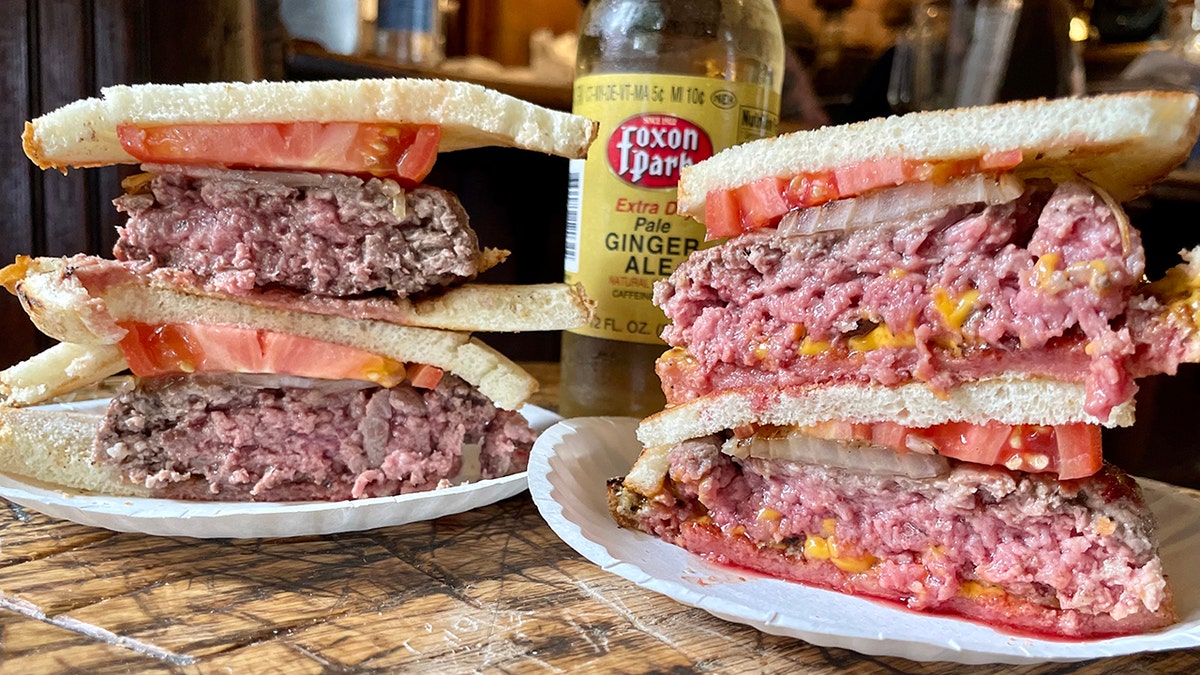
Louis Lunch of New Haven, Connecticut, invented the hamburger sandwich in 1900. Hamburgers are still served the traditional way between slices of Pepperidge Farm white bread toast. The only topping options are cheese, onion and/or tomato. (Kerry J. Byrne/Fox News Digital)
The family arrived in the United States in 1885, when Lassen was 19 or 20 years old. He married Sophia Kurtz, a native of Clermont County, Ohio.
They had at least three children, according to various historical records.
Lassen tried various careers before he became a street-cart food vendor. He turned his food wagon into a brick-and-mortar business on George Street in 1907.
CHICKEN WING RECIPE: SPICY, SWEET AND SAVORY ANY TIME OF YEAR
"The restaurant is so popular that when, in 1974, its owners faced eviction to make way for New Haven’s sweeping urban renewal program, New Haven residents protested," local historian Owen Rogers wrote last year for ConnecticutHistory.org.
The entire building was moved to its current location, at 261 Crown Street, in 1975.
The hamburger is not an American invention. Ground beef patties came from Hamburg, Germany, where they were served as an entrée.
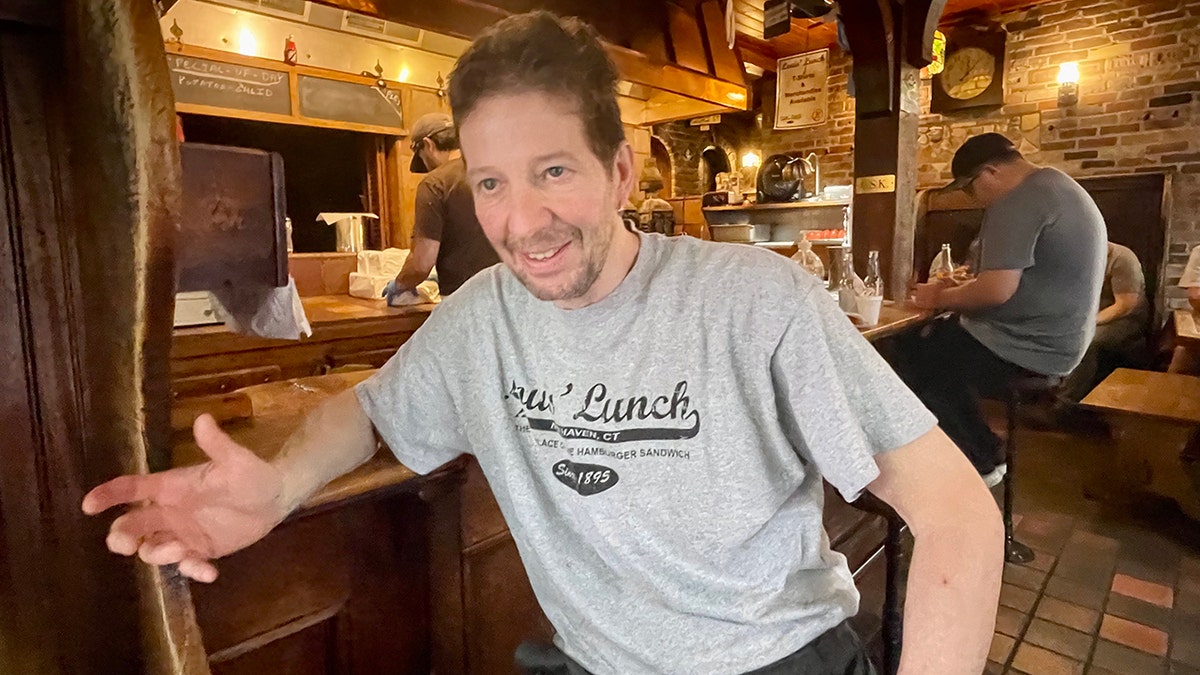
Jeff Lassen is fourth-generation owner of Louis Lunch in New Haven, Connecticut. His great-grandfather Louis Lassen founded the eatery in 1895 and invented the hamburger sandwich in 1900. (Kerry J. Byrne/Fox News Digital)
Hamburg is not far from the Danish border. It is likely the Lassens were familiar with hamburgers before arriving in the United States.
"Hamburgers in the late 1800s were ethnic food in America, no different than we look at empanadas today," burger historian and author George Motz told Fox News Digital.
The American innovation, Lassen's innovation, was making the hamburger mobile by serving it as a sandwich.
IS A SALAD ALWAYS A BETTER CHOICE THAN A SANDWICH? THINK TWICE ABOUT THAT
Ken Lassen, the late grandson of Louis Lassen, once relayed a remarkable tale of the history of the hamburger to food writer Michael Stern, publisher of RoadFood.com and author of numerous books in the "Road Food" series.

Louis Lunch flame-broils its burgers in 125-year-old stand-up cast-iron ovens. Founder Louis Lassen cooked the very first hamburger sandwiches in the same exact ovens from Bridge, Beach & Co. of St. Louis in 1900. (Kerry J. Byrne/Fox News Digital)
"You've heard of the Tartars? They rampaged through Europe, and one of the things they did was kill cattle," the third-generation Danish-American burger maker told Stern, who shared the story with Fox News Digital.
"But they didn't have time to stop and cook it, so they put hunks of it under their saddles and as they rode north, the meat got ground up by all the galloping and seasoned by the horses' sweat … and steak tartare was born! Finally, they stopped in Hamburg, Germany, long enough to cook it, and there you have a hamburger. But still without the bun."
"With a meat grinder and a streak of that infamous Yankee ingenuity, Louis Lassen changed the course of American culinary history."
The story sounds a bit wild, "but is largely true," said Motz, author "Hamburger America" and "The Great American Burger Book."
He disputes the fact that the Tartars raised and killed cattle. He said the Tartan raiders likely rampaged fueled by lamb or goat meat.
He also disputes that Lassen invented the hamburger sandwich. He traces hamburger sandwiches to state fairs around the country in the 1890s.

George Motz is the author "Hamburger America" and "The Great American Burger Book." He disputes the Louis Lunch hamburger sandwich origin story, but is also one of the Connecticut eatery's biggest fans. (George Motz)
A burger fan, meanwhile, sent him a clipping two years ago from the April 12, 1894, edition of the Shiner Gazette of Texas that cites "hamburger steak sandwiches every day in the week at Barny's saloon, Moulton."
The citing, he says, "would debunk any claim" made later.
He remains a devoted fan of Louis Lunch, however, even as he disputes its hamburger origin story.
MEET THE AMERICAN WHO INVENTED SLICED BREAD: OTTO ROHWEDDER, HARD-LUCK HAWKEYE
"Americans are proud of their hamburger heritage," said Motz. "At the very least, he [Lassen] helped popularize the hamburger."
Hold the ketchup
Louis Lunch today is a living museum of American culinary history.
"I describe it as going to burger church," said Motz.
"It’s heaven. It’s really heaven. You only go there to eat and to leave. You can only have it their way and there’s really something beautiful about that."
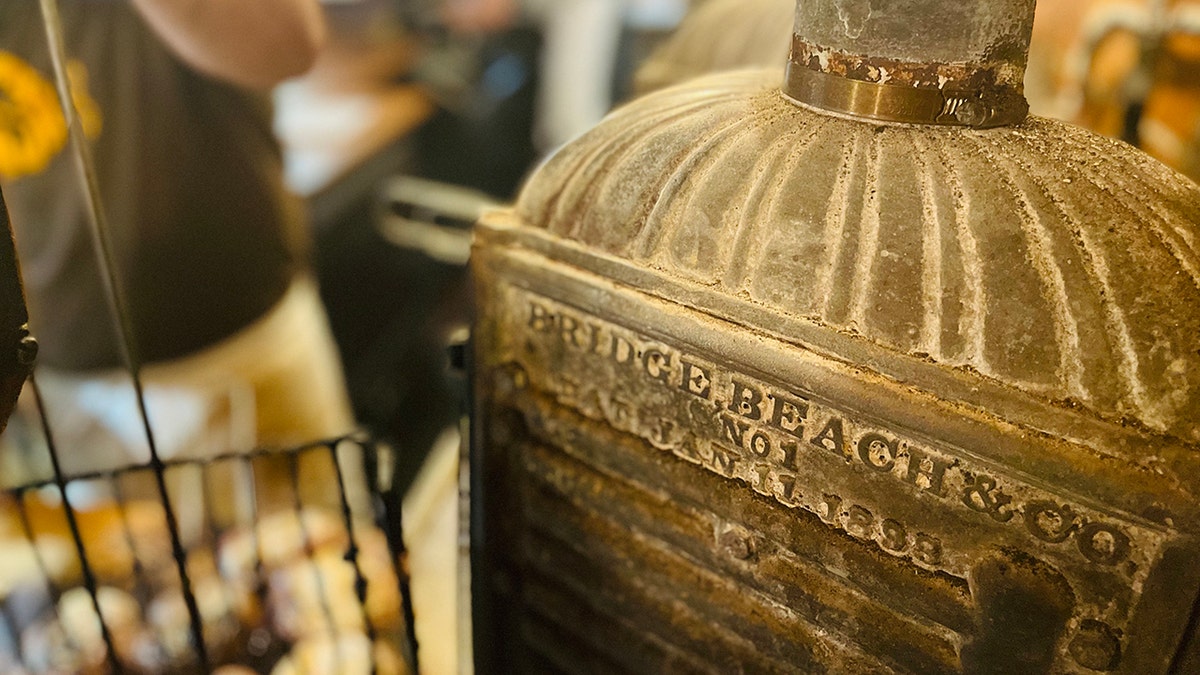
Louis Lunch flame-broils every hamburger in the same 125-year-old Bridge Beach & Co. cast-iron ovens first used by founder Louis Lassen when he invented the hamburger sandwich. (Kerry J. Byrne/Fox News Digital)
Guests from around the world savor hamburgers in the shadow of Yale University the same exact way Lassen prepared his first sandwiches more than a century ago.
Burgers are served with only three topping options: cheese, tomato and/or onion. The onions are roasted with the burgers.
There’s no lettuce. No mustard. No ketchup.
KETCHUP VS. MUSTARD: WHICH IS ‘BETTER' FOR YOU? EXPERTS CHIME IN ON THE DEBATE
"Condiments were invented to hide the flavor of the beef in an era when meat went bad," Louis Lunch proprietor Jeff Lassen, great-grandson of the founder, told Fox News Digital.
They may be the best hamburgers in America: fat, juicy, and flame-broiled in remarkable little 125-year-old cast-iron ovens manufactured by Bridge, Beach & Co. of St. Louis in 1898.

Louis Lunch of New Haven, Connecticut, is credited with inventing the hamburger sandwich in 1900. The menu today includes only hamburgers or cheeseburgers with a choice of onion or tomato; sides include only potato chips or potato salad, with sodas from local maker Foxon Park Beverages. (Kerry J. Byrne/Fox News Digital)
Louis Lassen served his very first hamburger sandwiches from the same exact ovens in 1900. The raw patties are placed between two grates and then flipped sideways and slid into the oven to roast to medium rare.
Louis Lunch burgers are served only on slices of white bread — the same way Louis Lassen served them in 1900.
"The hamburger," said Jeff Lassen, "existed before the hamburger bun."
MEET THE AMERICAN WOMAN WHO FOUNDED PEPPERIDGE FARM
Louis Lunch uses white bread from another Connecticut culinary icon: Pepperidge Farm, founded in the Nutmeg State by Margaret Rudkin in 1937.
Burgers can be ordered with potato chips or potato salad.

Michael Adams of New Haven, Connecticut, has been eating at Louis Lunch since the 1980s. He's a proponent of the hamburger pioneer's no-condiment mantra. "They want you to eat it the way they served it in the 1800s," said Adams. "That's what it's all about." (Kerry J. Byrne/Fox News Digital)
Homemade pie is often offered for dessert.
Many guests instinctively ask for lettuce, mustard or ketchup for their burgers — forcing Lassen to repeat the limited options to newcomers.
"This is the real deal. It’s no bulls---," said Motz. "Why would anyone want to impose their image of the guys who have been doing it for more than 100 years? Leave it alone. It’s dialed back the way it should be."
America's favorite food
Louis Lassen died on March 20, 1935. He was 69 years old.
He’s buried today at Evergreen Cemetery in New Haven beside his wife, Sophia.
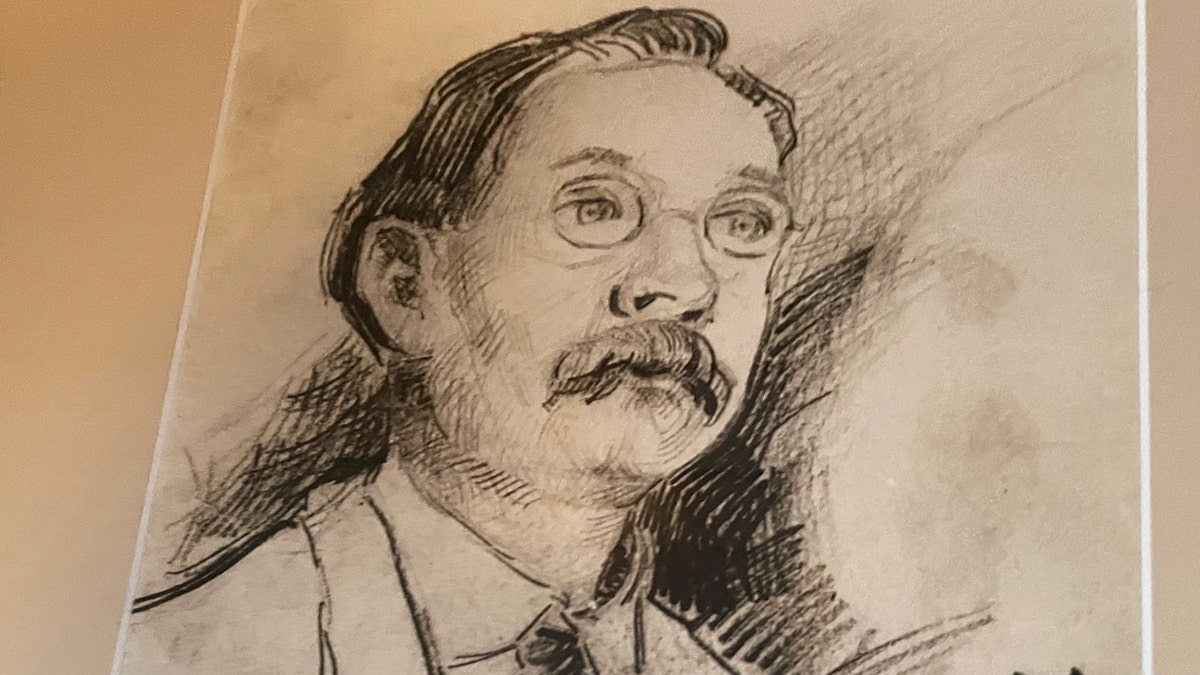
Louis Lassen, an immigrant from Denmark, is credited with inventing the hamburger sandwich at his eatery Louis Lunch in New Haven, Connecticut, in 1900. (Kerry J. Byrne/Fox News Digital; Lassen Family portrait)
Debate over the origins of the hamburger likely will linger forever.
What’s not in doubt is that Danish immigrant Lassen was instrumental in popularizing the hamburger in the United States.
And today there is no food in the United States that's more popular.
"Americans consume more than 50 billion burgers each year … an average of nearly three burgers per week for every American."
Americans consume more than 50 billion burgers each year, according to several industry estimates.
That’s an average of nearly three burgers per week for every American man, woman and child.
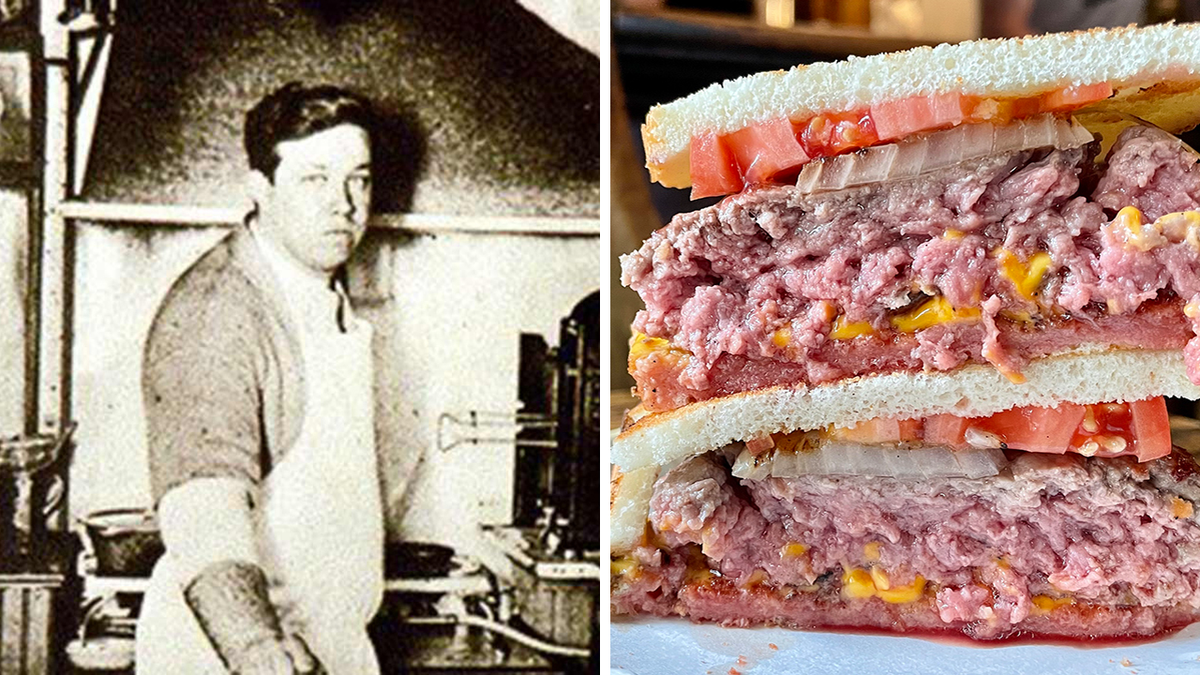
Louis Lassen, founder of Louis Lunch in New Haven, Connecticut, is credited with inventing the hamburger in 1900 when he placed sizzling beef between two pieces of bread. Louis Lunch still serves its hamburgers and cheeseburgers between slices of Pepperidge Farm white bread toast. (Louis Lunch; Kerry J. Byrne/Fox News Digital)
Louis Lunch may have enjoyed popular acclaim long before it achieved international recognition from the Library of Congress.
"The Whiffenpoof Song" is the traditional title tune performed by the Yale University Whiffenpoofs, proclaimed as the oldest collegiate a cappella ensemble in America.
"They want you to eat it the way they served it in the 1800s. That's what it's all about."
"To the tables down at Mory’s/To the place where Louie dwells" are the song’s opening lyrics.
A galaxy of America’s most celebrated stars have performed the tune. Rudy Vallee, Bing Crosby, Elvis Presley and Frank Sinatra all recorded versions of the Yale song.

Louis and Sophia Lassen are buried in Evergreen Cemetery in New Haven, Connecticut. Louis Lassen, born in Denmark, is credited as creator of the hamburger sandwich, an all-American culinary classic. (Courtesy Sean McKim)
"Mory’s" refers to Mory’s Temple Bar, a private club for Yale University students. The "Louie" most likely references one of the club’s owners, Louis Linder.
But many New Haven residents believe the song refers to beef patty peddler Louis Lassen.
CLICK HERE TO SIGN UP FOR OUR LIFESTYLE NEWSLETTER
Local resident Mike Adams, a Louis Lunch customer since the 1980s, appears to support the second theory. He notes that Louis Lunch burgers have long been a beloved late-night food for New Haven bar hoppers, Yale students notable among them.
He also supports the Lassen family's devotion to the no-condiment burger tradition.
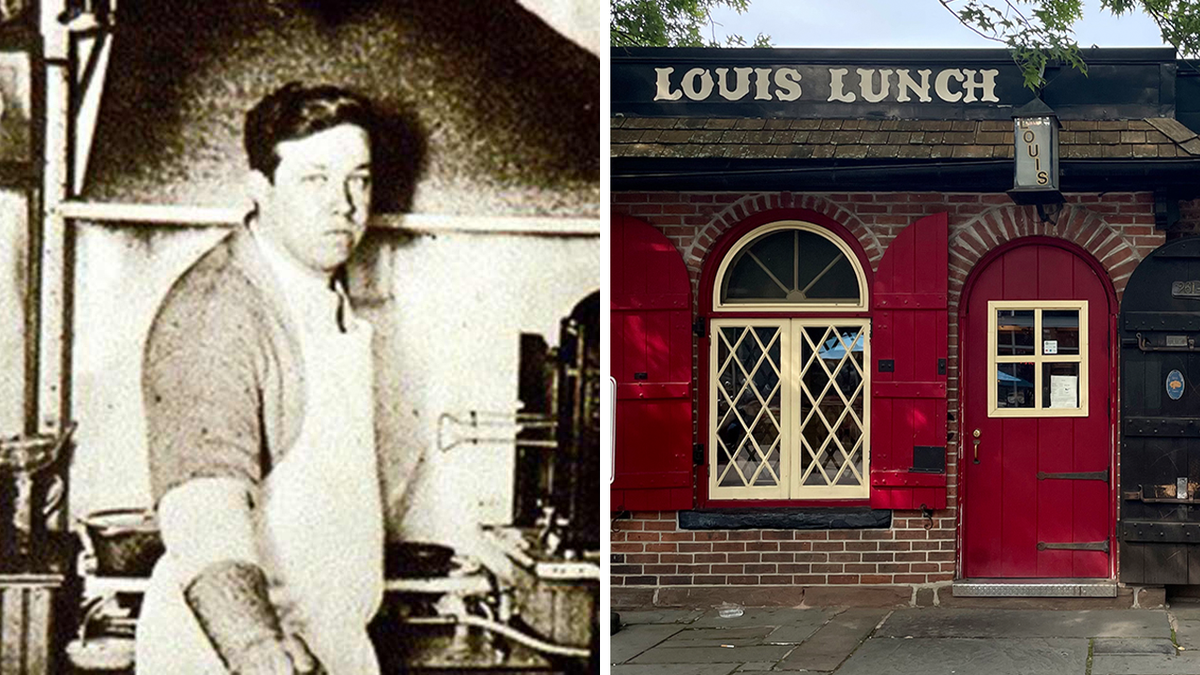
New Haven, Connecticut, street-cart food vendor Louis Lassen is credited by the Library of Congress as inventor of the hamburger sandwich. His namesake eatery, Louis Lunch, is a beloved New Haven institution today. (Lassen Family; Kerry J. Byrne/Fox News Digital)
"They want you to eat it the way they served it in the 1800s," said Adams. "That's what it's all about."
"Louis’ Lunch has held a special place in the hearts of the residents of New Haven for more than a century," Rep. DeLauro of Connecticut told Fox News Digital.
CLICK HERE TO GET THE FOX NEWS APP
"I encourage anyone visiting New Haven to stop at Louis Lunch. But whatever you do, don’t ask for ketchup!"
To read more stories in this unique "Meet the American Who…" series from Fox News Digital, click here.


